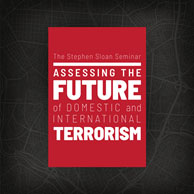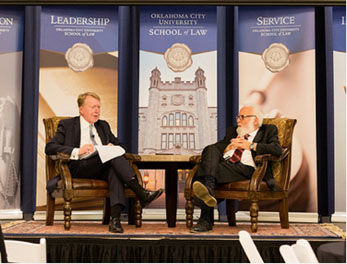Stephen Sloan Seminar: Assessing the Future of Domestic and International Terrorism
Robert J. Bunker

The Stephen Sloan Seminar was held 28 March 2019 at the Oklahoma City University School of Law, Oklahoma City, OK. The conference co-sponsored by The Murrah Center for Homeland Security Law and Policy at Oklahoma City University (OCU) School of Law and The Center for Intelligence and National Security at the University of Oklahoma (OU). It honors the groundbreaking contributions of Dr. Stephen Sloan to the field of counterterrorism over 40 years (a pioneer of the academic study of terrorism in the 1970s and author/co-author of 13 books) and brings together experts in counterterrorism analysis, policy, and national security law. The event had 50 attendees from academia, government, law enforcement, and the private security industry. A day prior to the event, a special archival tour of the holdings of the Oklahoma City National Memorial & Museum was provided to the attendees.

Dr. Stephen Sloan (Right) being interviewed by Michael J. Boettcher (Left)
Speakers at the seminar were Ms. Valerie Couch, Interim Director and Professor of Law, Murrah Center; Dr. James L. Regens, Regents Professor and Director, OU Center for Intelligence and National Security; and Marc Blitz, Alan Joseph Bennett Professor of Law at OCU Law School providing the welcoming remarks; Mr. Robert A. Kandra, Senior Advisor with the Cheroff Group and Advisor to the XK Group; The Honorable James E. Baker, Director, Institute for National Security and Counterterrorism, Professor of Law, Syracuse University of Law; Mr. Homer S. Pointer, Senior Fellow of the Murrah Center; Dean Jim Roth, OCU School of law providing lunch welcome remarks; Dr. Magnus Ranstorp, Research Director at the Centre for Asymmetric Threats Studies at the Swedish National Defense University; Mr. David N. Edger, Managing Director and founder of 3CI Consulting LLC; Dr. Stephen Sloan, Samuel Roberts Noble Foundation Presidential Professor Emeritus at OU; and Mr. Michael J. Boettcher, Gaylord Visiting Professor in the Gaylord College of Journalism and Mass Communications at OU. Session interview themes were “The Evolving Legal Framework of Counterterrorism” (Mr. Kandra), “The U.S. Perspective on the Future Direction of Terrorism” (Hon. Baker), “The European Perspective on the Future Direction of Terrorism” (Dr. Ranstorp; via Skype), and “Reflections on Forty Years of Counterterrorism Efforts, the Operational Dynamics of Terrorism, and What Lies Ahead” (Dr. Sloan).[1]
Key points and takeaways related to domestic and international terrorism futures (and retrospectives & response) raised at the conference from the perspective of the speaker are:
- The threat posed by White identity and supremacy groups in the United States, Europe, and Australia–New Zealand has been greatly promoted by internet technologies over the last 24 to 36 months. This trend leverages Marc Sageman’s Leaderless Jihad construct as a good overlay of what is taking place with ideological affinity (right wing identity) and TTP sharing evident. It is being promoted by Identity Evropa and related Neo-Nazi groups (Kandra).
- It is difficult to characterize White identity as only domestic terrorist groups when, in fact, they have become increasingly international in character. This begs the question whether a change in foreign terrorist organization (FTO) designation will be required to counter and prosecute such groups as in the case of material support to terrorism activities. Such FTO changes would require a pragmatic balancing of constitutional free speech and national security imperatives within the United States (Kandra).
- The jihadist threat is changing with the demise of the Caliphate. While the Islamic State had suffered a blow with the loss of its territory, the present leadership—Baghdadi leading the Islamic State (IS) and al Zawahiri and Hamza bin Laden (HBL) leading Al Qaeda (AQ)—still represent an ongoing threat having the capacity (either inspired or directly) to project attacks into population areas within the US and Europe. Further, IS may attempt to re-establish itself in the ungoverned spaces between Afghanistan and Pakistan to the detriment of AQ influence (Kandra).
- With respect to domestic terrorism, there are a number of emerging themes. The Christchurch attack illustrates the convergence of what are sometimes treated as distinct concepts referred to as domestic terrorism and international terrorism. They are not necessarily distinct concepts; motives and intent can merge, means can merge, and impacts can merge. One can inspire the other. Most importantly, from the standpoint of the victims it does not matter. We should be against all acts of violence whether that violence is motivated by domestic hate or international extremism, or other factors. Some have called for a domestic terrorism statute akin to the Title 18 criminal prohibition applicable to international terrorism. If that helps, fine. But Baker is inclined to favor the approach the military takes as well as that found in the multilateral conventions on aviation security, which focus on the underlying act of violence and not the motivation. My Lai, for example, was charged as murder, not as a war crime, as it surely also was. The conventions remove the political element by focusing on the act of violence, not the motive. That also removes an element of proof as well as a platform from which the defendant can espouse a motive. In domestic contexts, political actors may for various reasons find it hard to condemn acts of violence if they are called terrorism as opposed to murder, when they should be universally condemned by all. One area we should look at, and on an ongoing basis, is how the law authorizes certain investigative techniques and imposes different limitations on international efforts to deter terrorism from domestic acts of violence. There are Constitutional reasons for this, but we want to make sure that this nuanced area of law is understood and evolves with the threat and with the law (Baker).
- Christchurch, and other attacks, has and should prompt us revisit the question of corporate social responsibility when it comes to material that can incite acts of violence. We see in New Zealand and Australia efforts to address the responsibility of ISPs and social media platforms to report and remove what the Australian’s call “abhorrent violent material.” The First Amendment, of course, makes similar laws in the United States more complicated. Reasonable time, place, and manner restrictions are generally permitted by Courts—and thus we should avoid blanket assertions about what can and cannot be done—but what that means is often difficult to establish in context. And, we should not lose track of Section 230 of the Communications Decency Act of 1996, which gives ISPs a pass, with limited exception, on being liable for what is posted on their sites as a publisher of a newspaper might be liable. This is a statute and we ought to take another look at it based on our experience since 1996, and especially in the past few years. We should also take a look at the role of push algorithms in propagating wanted and unwanted material out to unwitting actors and audiences. Of course, corporations do not need a law to act with social responsibility. In the context of the Christchurch attacks, it is striking how narrow some of the content removal policies were at some of the ISPs and social media platforms; for example, one platform did not preclude the posting of suicides. There is nothing that prevents companies from constantly reviewing their policies to make sure they have got them right and that they are devoting enough resources to make them effective (Baker).
- Sloan initially taught a course on comparative political violence that was later followed by the first ever university course on international terrorism. Back in the 1970s, political violence was viewed in academia as a pathology. Brian Jenkins, RAND Corporation, Paul Wilkinson, University of St. Andrews, Martha Crenshaw, Wesleyan University, and Alex Schmid, United Nations, are also representative of some of the few terrorism scholars then existing. Sloan was influenced by his wife who taught improv theatre as he began his terrorist simulations which were unscripted and very realistic. The most he was ever paid was $1,000.00 for a full 24-hour plus full-scale exercise conducted against the Berlin Brigade. After their information was declassified, Sloan learned that his red team was the Delta detachment in Germany. They were probably the best “terrorists” in all the simulations he conducted. He later wrote about these exercises in Simulating Terrorism (UO Press, 1981). His motivation to engage in terrorism research was to ultimately to preserve human life (Sloan).
- While terrorism is increasingly networked and international, all terrorism is still local. To combat terrorism, you need to utilize asymmetric warfare. Stay away from stovepipes and instead create unity of effort under one incident command; ignore jurisdictions and politics. Terrorism is a form of protracted warfare and will only get worse in the future. Part of the issue is that we no longer have cohesive groups but cells, networks, and splinter entities. Further, some of our failure to respond steams from looking only at the now—we don’t look at futures and the strategic picture at all as terrorism scholars and practitioners. For example, the rise of virtual terrorism—using a SCADA system or the internet to kill large groups of people—is presently greatly underappreciated as a threat. Red teaming also has great value but is underutilized. Sloan and his students in the late 1970s identified the Alfred P. Murrah Federal building as a primary target in OKC—roughly two decades before the 1995 bombing (Sloan).
- The current political climate with its polarization and distrust of institutions unfortunately reminds one of aspects of the Weimar Republic of Germany. If there was a major terrorist incident, would our government overreact and declare its form of a “state of siege” or as in the civil war what was called a “constitutional dictatorship?” The militarization of the police and the increased involvement of the military in domestic law enforcement raises serious issues regarding potential threats to fundamental civil liberties, due process, and basic democratic values and practice. Unfortunately, the lack of civility and the erosion of a consensus has led the splintering of a “center.” We now face a crisis of legitimacy fueled by fear and division. We are in danger in this country of being subject to a form of auto-terrorism. We terrorize ourselves. Part of this is due to the fact that we are overwhelmed with data, too much questionable information, and an absence of that unique product called “wisdom.” These developments, in part, stem from the effects of social media on our populace. Our state based hierarchical system is breaking down in the face of advanced technology forms and the rise of non-state networks (Sloan).
Tapes of the above interviews are in the process of being transcripted for online posting. Additionally, Dr. Sloan’s terrorism library and papers have been donated to the Murrah Center archives which are available to visiting researchers. The point of contact for more information related to this event and Sloan Papers research is Valerie Couch (Interim Director of the Murrah Center). She can be reached at the Center’s email address: murrahcenter@okcu.edu.
End Note
[1] For more information on speaker bios, see Stephen Sloan Seminar.

